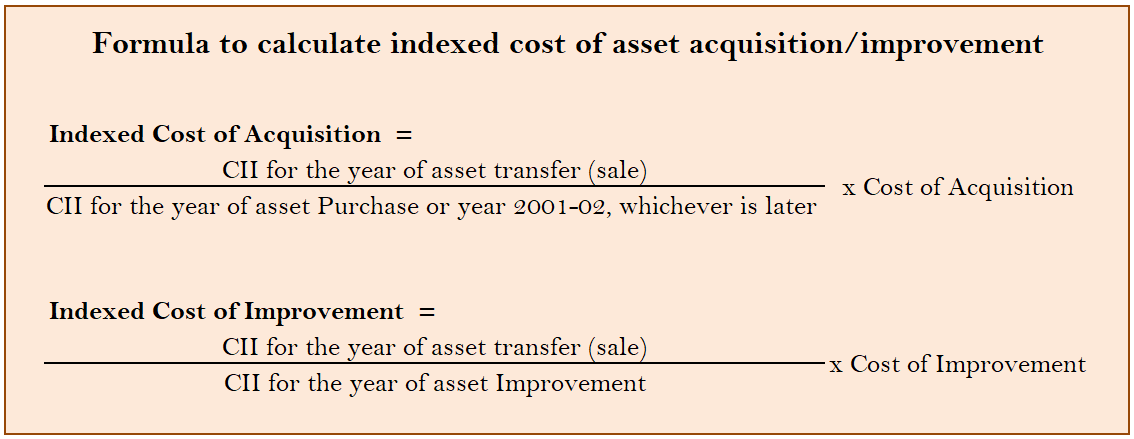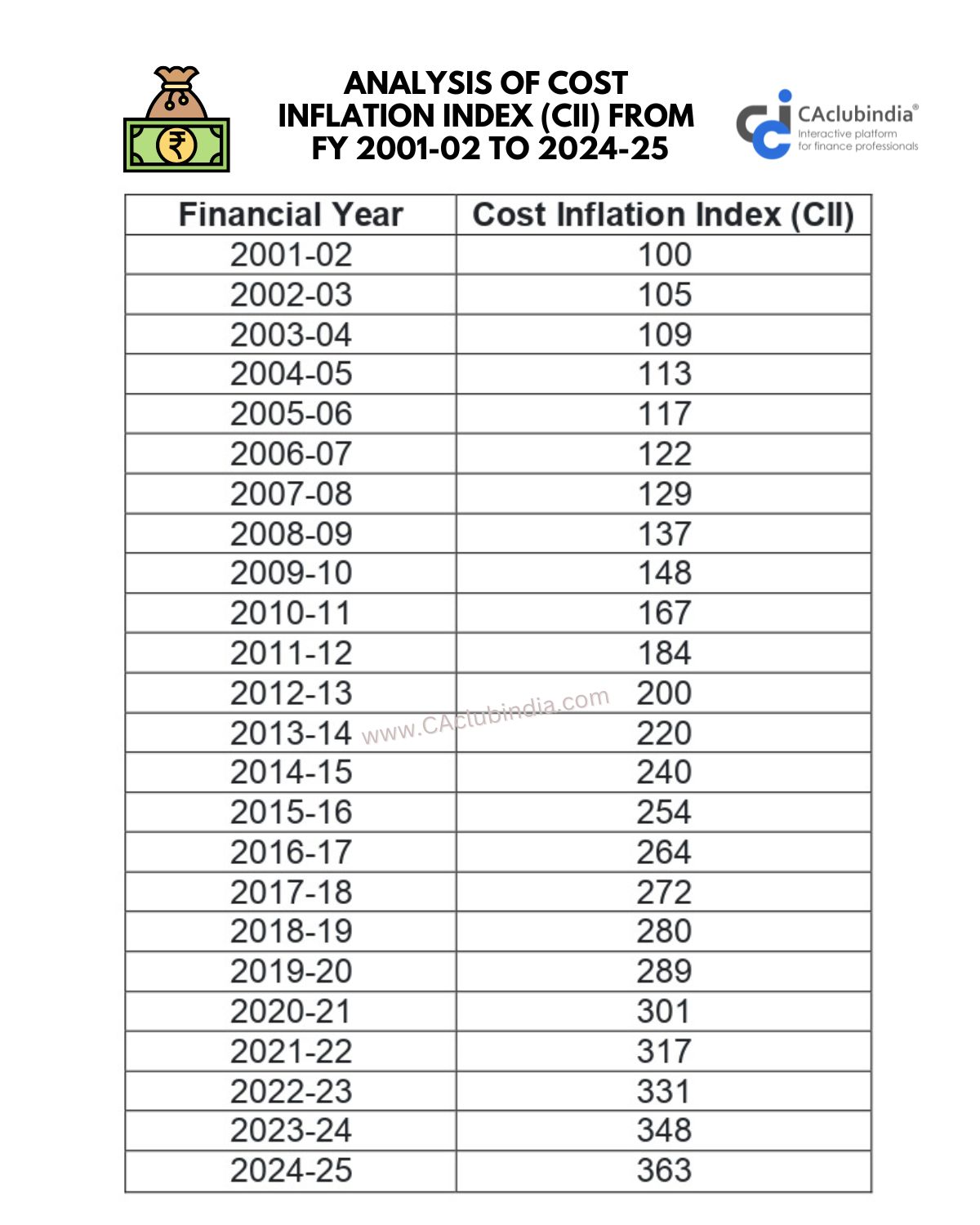Cost Inflation Index (CII) is a metric which is published annually by the Income Tax Department for calculating long-term capital gains on investments.
The CII for FY 2024-2025 as notified by CBDT is 363.
Table of Contents
- Introduction
- What is the Cost Inflation Index (CII)?
- How is Cost Inflation Index used in Income Tax?
- How indexation benefit can be applied to long-term capital assets?
- How to calculate Indexed Cost of Acquisition for long term capital assets?
- What is the Base Year Concept?
- What was the base year before 2001-2002 for CCI Calculation?
- What is the current Cost Inflation Index for FY 2023-2024?
- Conclusion
Introduction
It is a matter of fact, that the value of rupee today will not be the same tomorrow. Due to inflation, prices keep on increasing which results in a fall of purchasing power. For example if ten years back you could afford two packets of bread for Rs 20, now probably you can afford only one packet of bread for Rs 20. This is due to the fall in the value of money and thus fall in the purchasing power. Now you must be wondering, how can one measure this change in purchasing power, increase in the prices of goods due to inflation? And here comes the role of Cost Inflation Index (CII).
We are well aware that the income of an individual from different heads i.e. Salary, Income From House Property, Profits and Gains from Business and Profession, Capital Gains, and Other Sources is taxed in his hands. Cost Inflation Index is a widely used concept while calculating Capital Gains and therefore it is also well known as Capital Gain Index. It helps us save a lot of tax as while computing the profit/gains from selling any long term asset, an assessee is given the benefit of indexation. That is the inflation adjusted cost of the asset is taken into consideration while computing profit/loss on sale of an asset. This article aims to address the following frequently asked question on Cost Inflation Index:

What is the Cost Inflation Index (CII)?
Cost Inflation Index is a measure to calculate the increase in the price of goods and assets over a period of time due to inflation. It helps to calculate the actual price of the asset in any year. And thus the actual profit/loss on sale of the asset in any year. CII benefit is applicable for capital assets like real estate, gold, debt, mutual funds or debentures. So, if you are selling these assets, you better take advantage of CII.
Points to remember:
• One must note that CII comes handy for calculation of long term capital gain/loss, not when you are having short term capital gain/loss.
• CII cannot be used to compute long term capital gains on equity mutual funds as they are taxed at a flat rate of 10% without indexation benefit.
How is Cost Inflation Index used in Income Tax?
The Cost Inflation Index is used to adjust the purchase price of long-term capital assets for inflation. This adjustment helps to reduce the taxable profit when the asset is sold because the indexed cost is subtracted from the sale price to calculate capital gains.
How indexation benefit can be applied to long-term capital assets?
Cost Inflation Index helps to adjust the purchase price of capital assets against the sale value. The formulas are :

How to calculate Indexed Cost of Acquisition for long term capital assets?
Let us assume that you purchased a property in 2015 for Rs. 15 Lakh. Now, you have sold the same in 2021 at Rs. 40 lakhs. So, the capital gains without using CII is Rs. 25 Lakhs (40 lakhs - 15 lakhs). You will now have to pay taxes on Rs. 25 lakhs. But with CII, you can get capital gains reduced. Have a look:
Indexed Cost of Acquisition = Actual Purchase Price * (CII of Year of Sale/ CII of Year of Purchase)
Therefore, Indexed Acquisition Cost= 15,00,000 x 317/254 = 1872047.24
So, the Indexed Cost of Acquisition(Inflation adjusted cost of acquisition) will be Rs. 1872047.24. For tax purpose, the cost of property purchase will be only Rs. 1872047.24 not 15,00,000. Due to this, your capital gains will fall from 25,00,000 to Rs. 2127952.76. Tax will now be paid on this lower amount of Rs. 2127952.76.
What is the Base Year Concept?
CII has a base year concept. The base year is the first year for which we know the Cost Inflation Index. 2001-2002 is taken as the base year for CCI Calculation and the index value is equal to 100 for 2001-2002. So, what will the cost inflation index be for years before 2001-2002.
If you have purchased the asset before the base year i.e. 2001-02, then the cost of acquisition will be the higher of
• The actual cost of the asset or
• FMV on 1st April 2001
What was the base year before 2001-2002 for CCI Calculation?
The base year before 2001 was 1981 which has been shifted by the government as the taxpayers faced difficulties in valuing properties purchased before April 1, 1981, as the base year was set at 1981-82.
What is the current Cost Inflation Index for FY 2024-2025?
The Central Board of Direct Taxes (CBDT) notifies the CII every year in the official gazette. Here is the table of year-wise Cost Inflation Index since 2001-02:

Conclusion
We know that the value of the money keeps changing and so does the purchasing power of an individual due to inflation. CII is a measure to calculate the change in the prices of goods/purchasing power over time. Cost Inflation Index is a very important concept in taxation, to calculate the actual profit/loss on the sale of any long term capital asset. Through CII the taxpayer can calculate the inflation adjusted cost of the asset, that is the actual cost of the asset in the year of sale.






 CAclubindia
CAclubindia

